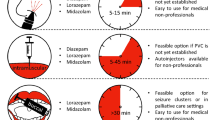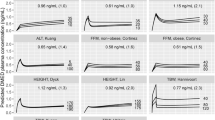Abstract
We have pharmacodynamically modeled the relationship between the thiopental serum concentration and its effects on the electroencephalogram (EEG). Power spectral analysis was used to calculate the spectral edge, a measure of the underlying EEG frequency that characterizes the progressive slowing of the EEG induced by thiopental. Eight male volunteer subjects had venous thiopental serum concentrations measured, and 10 surgical patients had arterial serum concentrations measured. Thiopental was infused at a rate of 75 to 150 mg/min until a burst suppression EEG pattern was evident. Frequent blood samples were obtained during and after the infusion for measurement of serum thiopental concentrations, and the EEG was recorded for subsequent off-line power spectral analysis to calculate the spectral edge. With venous blood sampling, it was not possible to demonstrate significant hysteresis between the thiopental serum concentration and the spectral edge, allowing thiopental concentrations to be directly related to the spectral edge. With arterial blood sampling, significant hysteresis was present, requiring an effect compartment to relate concentration to effect. The half-time for equilibration (mean ± SD) between concentration and response for the arterial data was 1.2± 0.30min. This value for Keo is consistent with known values for cerebral blood flow and thiopental brain: blood partition coefficient. Arterialvenous concentration differences cause the apparent lack of hysteresis with venous blood sampling. An inhibitory sigmoid E max pharmacodynamic model optimally characterized the relationship between thiopental concentrations and the spectral edge. This model allows estimation of the thiopental serum concentration that causes one-half of the maximal EEG slowing (IC50), which is a measure of an individual's sensitivity to thiopental. Except for the hysteresis, there was no statistical difference in the parameters of the inhibitory sigmoid E max pharmacodynamic model when venous and arterial blood samplings were compared. Arterial blood sampling offers some distinct advantages when pharmacodynamically modeling continuous, rapidly changing measures of drug effect, such as the EEG.
Similar content being viewed by others
References
N. H. G. Holford and L. B. Sheiner. Kinetics of pharmacologie response.Pharmac. Ther. 16:143–166 (1982).
N. H. G. Holford, P. E. Coats, T. W. Guentert, S. Riegelman, and L. B. Sheiner. The effect of quinidine and its metabolite on the electrocardiogram and systolic intervals: Concentration-effect relationships.Br. J. Clin. Pharmacol. 11:187–195 (1981).
B. Whiting, A. W. Kelman, J. Barclay, and G. J. Addis. Modelling theophylline response in individual patients with chronic bronchitis.Br. J. Clin. Pharmacol. 12:481–487 (1981).
D. R. Stanski, J. Ham, R. D. Miller, and L. B. Sheiner. Pharmacokinetics and pharmacody-namics of d-tubocurarine during nitrous oxide-narcotic and halothane anesthesia in man.Anesthesiology 51:235–241 (1979).
A. L. Quasha, E. I. Eger, II, and J. H. Tinker. Determination and applications of MAC.Anesthesiology 53:315–334 (1980).
R. D. Waud. On biological assays involving quantal responses.J. Pharmacol. Exp. Ther. 183:577–607 (1972).
L. E. Mather, T. L. Seow, J. G. Roberts, G. K. Gourlay, and M. J. Cousins. Development of a model for integrated phamacokinetic-pharmacodynamic studies of intravenous anesthetic agents: Application to minaxolone.Eur. J. Clin. Pharmacol. 19:371–381 (1981).
R. J. Hudson, D. R. Stanski, L. J. Saidman, and E. Meathe. A model to study the depth of thiopental anesthesia and acute tolerance.Anesthesiology 59:301–308 (1983).
P. K. Kiersey, R. G. Bickford, and A. Faulconer. Electroencephalographic patterns produced by thiopental sodium during surgical operations.Br. J. Anaesth. 23:141–152 (1951).
W. J. Levy, H. M. Shapiro, G. Maruchak, and E. Meathe. Automated EEG processing for intraoperative monitoring: A comparison of techniques.Anesthesiology 53:223–236 (1980).
D. R. Stanski, P. G. Burch, S. Harapat, and R. K. Richards. The pharmacokinetics and anesthetic potency of a thiopental contaminant isomer.J. Pharm. Sci. 72:937–940 (1983).
I. J. Rampil, F. J. Sasse, N. T. Smith, B. H. Holf, and D. C. Fleming. Spectral edge frequency—A new correlate of anesthetic depth.Anesthesiology 53:S12 (1980).
R. L. Galeazzi, L. Z. Benet, and L. B. Sheiner. Relationship between the pharmacokinetics and pharmacodynamics of procainamide.Clin. Pharmacol. Ther. 20:278–289 (1976).
A. L. Nichols and C. L. Peck. LSNLR—General weighted least squares nonlinear regression program. Technical Report No. 5. Division of Clinical Pharmacology, Uniformed Services University for the Health Sciences, Bethesda, Md. (May 1981).
L. B. Sheiner, D. R. Stanski, S. Vozeh, R. D. Miller, and J. Ham. Simultaneous modelling netics and pharmacodynamics: Application to d-tubocurarine.Clin. Pharmacol. Ther. 25:358–371 (1979).
D. L. Clark and B. S. Rosner. Neurophysiological effects of general anesthetics. I. The electroencephalogram and sensory evoked response in man.Anesthesiology 38:564–582 (1973).
H. L. Price, P. J. Kounat, J. N. Safer, E. H. Conner, and M. L. Price. The uptake of thiopental by body tissues and its relation to the duration of narcosis.Clin. Pharmacol Ther. 1:16–22 (1960).
H. L. Price, J. W. Dundee, and E. Conner. Rates of uptake and release of thiopental by human brain: Relation to kinetics of thiopental anesthesia.Anesthesiology 18:171 (1957).
Author information
Authors and Affiliations
Additional information
This work was supported by NIH Grant R23-GM28032, NIA Grant P01-AG03104, the Veterans Administration Research Service, and the Anesthesiology/Pharmacology Research Foundation of Palo Alto, California. Dr. Hudson was supported by the Medical Research Council of Canada.
Rights and permissions
About this article
Cite this article
Stanski, D.R., Hudson, R.J., Homer, T.D. et al. Pharmacodynamic modeling of thiopental anesthesia. Journal of Pharmacokinetics and Biopharmaceutics 12, 223–240 (1984). https://doi.org/10.1007/BF01059279
Received:
Revised:
Published:
Issue Date:
DOI: https://doi.org/10.1007/BF01059279




